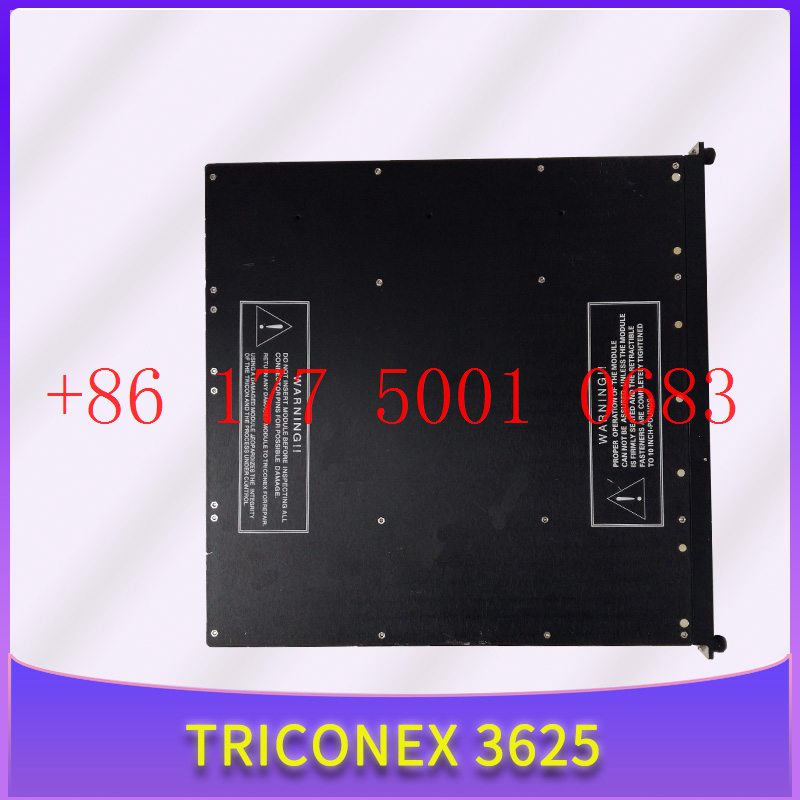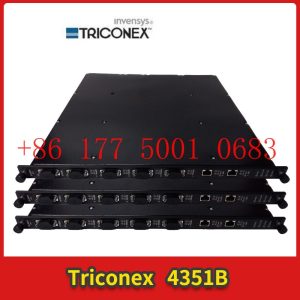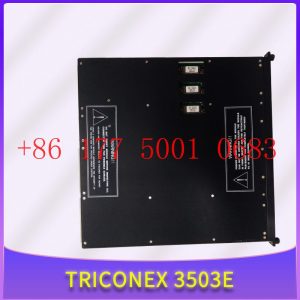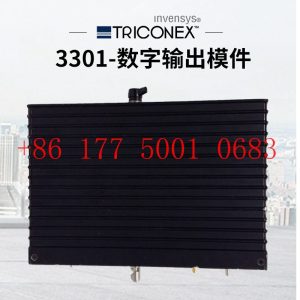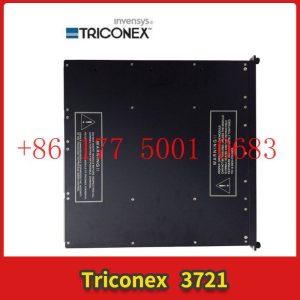Description
3626X TRICONEX nput/output communication card
3626X TRICONEX nput/output communication card
Module Clips Drive controller servo motor
Contact: Mr. Lai
Wechat:17750010683
Whats app:+86 17750010683
Skype:+86 17750010683
QQ: 3221366881
3221366881@qq.com
What are the types of integrated IO modules3626X TRICONEX nput/output communication card
For a programmable logic controller, IO fulfills the responsibilities of data acquisition and instruction output. What control objectives can a PLC achieve, and the quantity and type of IO are crucial. For general integrated PLCs, the number and types of IO interfaces are constant. Some friends may ask, what if you encounter a complex control project with insufficient IO ports in the PLC? Don”t worry, nowadays PLCs have communication interfaces that can be connected to other IO couplers to achieve IO expansion. So, what are the types of IO modules that we can integrate in our daily lives? Actually, it can be mainly divided into four categories, namely:
1. Digital signal acquisition IO can achieve discontinuous signal acquisition, and a typical IO type is a counter input IO module.
Technology Oasis • Source: Guangcheng CAN Bus • Author: Guangcheng CAN Bus • 2022-05-09 09:52 • 1740 readings
For a programmable logic controller, IO fulfills the responsibilities of data acquisition and instruction output. What control objectives can a PLC achieve, and the quantity and type of IO are crucial. For general integrated PLCs, the number and types of IO interfaces are constant. Some friends may ask, what if you encounter a complex control project with insufficient IO ports in the PLC? Don”t worry, nowadays PLCs have communication interfaces that can be connected to other IO couplers to achieve IO expansion. So, what are the types of IO modules that we can integrate in our daily lives? Actually, it can be mainly divided into four categories, namely:
1. Digital signal acquisition IO can achieve discontinuous signal acquisition, and a typical IO type is a counter input IO module.
2. Digital output IO, which can send out command signals of digital quantities to control actuators, such as PWM IO, can send pulse signals to control servo motors and stepper motors. In addition to PWM IO, we often use relay output type IO.
3. After discussing digital IO, let”s talk about analog IO. Firstly, analog input IO includes voltage analog input IO, current analog input IO, temperature analog input IO, etc. They collect continuous signals.
4. Finally, there is the output type IO of analog quantity, mainly including voltage analog quantity output type IO and current analog quantity output type IO. Some friends may ask why there is no temperature this time, but there are relatively few applications, mainly based on voltage and current types.3626X TRICONEX nput/output communication card
Industrial automation solutions, starting with remote IO modules!
The remote IO module is mainly used for collecting analog and digital signals on industrial sites, and can also output analog and digital signals to control equipment. It is possible to expand the input and output ports of data processing equipment such as PLCs and collection instruments. For example, a PLC only has 10 analog input interfaces, but if 30 analog quantities need to be collected on site, remote IO expansion needs to be added.
Furthermore, due to the distance between the equipment and the main control PLC or industrial computer, RS-485 bus is usually used for transmission. There are also some factories with high levels of automation that use industrial Ethernet to control remote IO modules. In the past, when laying lines between equipment and cabinets, people had to connect them one by one, which greatly increased the cost of cables and construction time. Moreover, if the distance was relatively long, they also faced problems such as voltage attenuation. And with the remote IO module, it effectively solves this problem. If your cabinet is 200 meters away from the site and you do not use remote IO, then you need to lay out each signal line for 200 meters. Installing the remote IO module on site can save you a lot of cable costs and reduce the complexity of construction from a cost perspective.
Simply put, sometimes some IO is set up in the on-site device cluster, which can be connected to the PLC through a communication cable to send the signal to any place where it is needed, saving wiring and PLC”s own IO points. Sometimes, the logical “remote” is because the allowed number of “local IO” cannot meet the actual needs, and it needs to be connected to the “remote IO template”, depending on the actual situation.
In addition, the general cabinet room is located on the device site. But some control signals, such as emergency stop and bypass, are implemented in the control room, so remote IO modules need to be used to send these signals to the control system in the cabinet room.
Why use remote I/O?
1. Because in some industrial applications, it is impossible to install PLCs with local I/O modules near on-site equipment due to harsh environments.
2. When you want to place the I/O module near the field device to eliminate long multi-core cables, you can receive signals from distant sensors and send remote control signals to control valves, motors, and other final actuators. The signal can be transmitted at any distance using various transmission protocols such as Ethernet and Profibus through high-speed media such as twisted pair and fiber optic.
3. Multiple transmission protocols such as Ethernet and Profibus can be used to send signals at any distance on high-speed media such as twisted pair and fiber optic.
The barium rhenium technology MXXT remote IO module uses industrial grade components with a wide working voltage of DC9-36V, which can operate normally within the range of -20~70 ℃. It supports RS485/232 communication mode, and the communication protocol adopts standard Modbus TCP protocol, Modbus RTU over TCP protocol, and MQTT protocol. We strive to fully meet the needs of our customers with an electrical and mechanical system that is anti-interference, resistant to harsh environments, and compatible with general use. It has stable performance, reliable quality, short delivery time, and fast response.
Advantages of Barium Rhenium Remote I/O Module
1. It can be controlled by remote commands.
2. Save the cost of using industrial control computers and IO cards, and Ethernet I/O modules can be directly connected to the upper computer system;
3. Replacing 4-20mA signal transmission with 10/100MHz Ethernet transmission has improved transmission speed;
4. Replacing various instrument controller signal lines with an Ethernet cable reduces the attenuation of remote signal transmission;
5. The signal cable of the instrument controller only needs to be connected to the Ethernet I/O module, greatly reducing cable costs and wiring workload.
6. Convenient installation method. Rail installation, high reliability, strong anti-interference ability, and more convenient on-site installation.
Ethernet IO module assists industrial robots
Industrial robots are multi joint robotic arms or multi degree of freedom machine devices aimed at the industrial field, which can achieve many material distribution, retrieval, pallets, and so on in industrial sites. However, due to the fact that many industrial six axes are equipped with 32 IO ports as standard, the IO ports are not sufficient in practical applications. Therefore, some DIN and DO extensions can be met through IO modules.
MQTT Ethernet IO Remote Module3626X TRICONEX nput/output communication card
The Modbus TCP Ethernet IO module has multiple channels, such as 4-way, 8-way, and 16-way switch input and output options. The communication protocol of the Ethernet IO module adopts the standard Modbus TCP protocol, Modbus RTU over TCP protocol, and MQTT protocol. Can support LAN configuration, with 1 DC power output to other devices on site, reducing the difficulty and cost of on-site wiring.
Most of the MQTT Ethernet IO modules should collect some IO port information and transmit data through the network port. In fact, the Ethernet IO module can not only serve as a TCP server, but also as a TCP client. In addition, it can not only count high-speed pulses but also output high-3626X TRICONEX nput/output communication cardspeed pulses. This is very convenient for doing some control processing on industrial sites, such as controlling servo motors and other scenarios! The most important thing is the data caching function. Even if the network is disconnected, it is not afraid. The data will be automatically cached, and after the network is restored, it will be automatically retransmitted.
The MxxxT industrial remote Ethernet I/O data acquisition module is embedded with a 32-bit high-performance microprocessor MCU, and integrates an industrial grade 10/100M adaptive Ethernet interface to support the standard Modbus protocol. It can easily integrate with third-party SCADA software, PLC, and HMI devices for application. Equipped with an RS485 interface, it has good scalability and can be cascaded with standard Modbus RTU I/O devices through the RS485 bus to achieve the combination of various digital, analog, and thermal resistance IO modules, saving costs. At the same time, this device has the function of cluster register mapping, and the data of the cluster is automatically collected into the mapping storage area of the local computer. The upper computer can respond quickly without waiting when querying, meeting the strict and timely functional requirements of industrial sites.
What is a remote IO module and what are its purposes
Technology is constantly evolving, and we can come into contact with various electronic devices both in daily life and in the workplace. And a large number of electronic devices work together to generate some signal sources. In order to better transmit and collect signals, industrial control products such as remote IO modules, signal transmitters, and signal acquisition modules have been developed.
In the past, people had to connect existing lines and boxes one at a time, which greatly increased the cost and construction time of cables. Moreover, if the distance was too long, they also had to face issues such as voltage attenuation. And through the remote IO module, this problem can be effectively solved.
If your cabinet is 200 meters away from the site and remote IO is not used, then you can extend each signal line by 200 meters and install the remote IO module on site, which can save you a lot of cable costs and reduce the complexity of construction.
In short, sometimes some IOs are set far away from the central control room and then connected back to the central control room through fiber optics to save on cable procurement and construction. Sometimes, the logical “remote” is because the allowed quantity of “local IO” cannot meet the actual needs, so it is necessary to connect to the “remote IO template”, which depends on the situation.
In addition, the general cabinet is placed on the equipment site. However, some control signals, such as emergency stop and bypass, are implemented in the control room, so remote IO modules need to be used to transmit these signals to the control system in the computer room.
What is an Ethernet IO module and what are its functions
The Ethernet IO module is a hardware gateway that adds IO to the network port.
The Ethernet IO module has hardware interfaces such as switches, analog signals, relays, RS485, RJ45, etc. Can be used for IO data collection network port transmission in industrial automation. Simply put, it refers to sensors with standard signals on site, or serial devices with 485 signals such as PLCs, which can be converted into real values through such gateways and then transmitted to the host for display through network ports.
1. Collect and control data for internal processing and transmit it to the external network through Ethernet
2. Support 4-way photoelectric isolation switch input
3. Supports 4 independent relay control outputs
4. Supports 8 analog inputs, 4-20mA or 0-5V/0-10V/0-30V (optional)
5. Support RS485 serial port data collection, with serial port server function
6. Supports Modbus RTU communication protocol and virtual serial port
7. Supports docking with various configuration software and TCP/UDP servers
What are the characteristics of a demonstration system based on IO Link slave stations
IO Link is an industrial communication interface that is independent of any fieldbus and suitable for simple sensors and actuators at the lowest level of industrial control. The IO Link system includes IO Link devices (such as sensors and actuators), IO Link master stations, and cables for standard sensors. The system structure is shown in Figure 1. For example, when a remote IO module compatible with EtherNet/IP serves as the master station, in addition to standard I/O signals, the module sends and receives configuration data, diagnostic data, or enhanced process data through a pulse modulation process, which is then packaged into EtherNet/IP data packets and finally transmitted to the network master station, usually a PLC. In the above applications, the connection between remote I/O and IO Link devices remains the same as that of traditional discrete devices. The advantage of IO Link mainly lies in its greater information exchange capability, which was previously impossible to achieve with standard I/O devices. Another advantage of IO Link is that it does not rely on any fieldbus, and through any I/O module that complies with the IO Link protocol (including local I/O and remote I/O), IO Link sensors or actuators can be integrated into any fieldbus system.
In order to further study the architecture, communication mechanism, and development application of the IO Link system, an IO Link slave toolkit can be designed and developed, including a universal development module for IO Link, an IO Link analysis tool, and an IO Link slave protocol stack. The IO Link universal development module is the foundation for this work and also serves as a bridge between the IO Link master station and equipment signals. The IO Link analysis tool can help developers and testers analyze communication details to identify and solve problems. The IO Link slave protocol stack is a firmware library that provides a hardware abstraction layer and application program interface, allowing developers to easily and quickly develop IO Link slave products on various microprocessor platforms. The IO Link slave station studied in this article only focuses on digital (button) signal input and digital signal output (indicator light). The design of the IO Link universal development module only needs to be expanded on this basis to have the ability to process analog signals.
The IO Link Master module used in this article, USB IO Link Master, can connect IO Link devices to a PC, which can be configured and tested through the IO Link Device Tool software or demonstrated device functionality. IO Link devices must be described through a device description file (IODD file), which includes a set of XML text files and PNG graphic files, which contain information about device identification, communication characteristics, parameters, process data, and diagnostic data. The portion within the elliptical dashed line in Figure 2 is an IO Link three wire cable, with L+/I – being a 24 V DC power supply and C/Q being a signal line used to transmit process data, diagnostic data, configuration data, etc. The IO Link universal development module is mainly composed of data transceivers and microprocessors. It can process input signals from sensors and transmit information to the IO Link master station. It can also receive and process data information from the master station and transmit it to the actuator. The IO Link analysis tool can help developers view, record, analyze data, and understand communication details. This part of the design is not discussed in this article.
Introduction to IO Link Communication Mode3626X TRICONEX nput/output communication card
IO Link devices can operate in SIO mode (standard I/O mode) or IO Link mode (communication mode). After power on, the device always operates in SIO mode. The port of the main station has different configuration methods. If configured in SIO mode, the main station considers the port as a standard digital input. If configured in communication mode, the main station will automatically identify the communicable devices for communication.
2.1 Data Types3626X TRICONEX nput/output communication card
The three basic data types for IO Link communication are periodic data (or process data PD), non periodic data (or service data SD), and event.
The process data (PD) of the device is transmitted periodically in the form of a data frame, while service data (SD) is only exchanged after the master station issues a request. Figure 3 shows a typical IO Link message structure. When an event occurs, the “event flag” of the device is set, and the main station reads the reported event (service data cannot be exchanged during the reading process) upon detecting the setting. Therefore, events such as pollution, overheating, short circuits, or device status can be transmitted to the PLC or visualization software through the main station
2.2 Parameter data exchange
Since service data (SD) must be transmitted through PLC requests, SPDU (Service Protocol Data Unit) is defined. In the main station, requests for read and write services are written to SPDU and transmitted to devices through the IO Link interface.
The general structure of SPDU is shown in Figure 4, and its arrangement order is consistent with the transmission order. The elements in SPDU can take different forms depending on the type of service. SPDU allows access to data objects that are intended for transmission, while Index is used to specify the address of the requested data object on the remote IO Link device. In IO Link, there is a term called direct parameter page, which stores parameter information such as minimum cycle time, supplier ID, and master station commands. The data objects accessible in the direct parameter page can be selectively provided through SPDU.
HMT7742 is an IO Link slave transceiver chip that serves as a bridge between the MCU of external sensors or actuators and the 24V signal line that supports IO Link communication. When the IO Link device is connected to the master station, the master station initializes communication and exchanges data with the MCU. HMT7742 serves as the physical layer for communication.
Due to the fact that the three indicator lights (rated voltage 24 V) controlled by the output port of the MCU are powered by the IO Link power cord, it is necessary to monitor the current on the power cord in order to trigger appropriate corrective measures when the current exceeds a set threshold, such as removing the indicator lights from the IO Link power cord. The current monitoring module uses an INA194 current detection amplifier. As a high detection current detector, INA194 is directly connected to the power supply and can detect all downstream faults. It has a very high common mode rejection ratio, as well as a large bandwidth and response speed. It can amplify the voltage on the induction resistor 5O times and output it to the forward input terminal AIN0 of the MCU internal voltage comparator. When the voltage value of AIN0 exceeds the threshold set at the reverse input terminal, By controlling the low level output of PB0, the indicator LAMP can be cut off from the IO Link power line to achieve overcurrent protection function. This part of the circuit is shown in Figure 6.
How to Build High Channel Density Digital IO Modules for the Next Generation Industrial Automation Controllers
With the rapid development of industrial automation, digital IO modules have become an indispensable part of industrial automation controllers. The digital IO module can connect the controller with external devices, such as sensors, actuators, etc., to achieve monitoring and control of industrial production processes. However, with the continuous development of industrial automation, digital IO modules need to have higher channel density and stronger functionality to meet the needs of new industrial automation controllers. Therefore, it is very important to build high channel density digital IO modules for the next generation of industrial automation controllers.
The digital IO module is one of the most fundamental modules in industrial automation controllers, and its main function is to connect the controller with external devices to achieve signal input and output. The digital IO module usually includes two parts: a digital input module and a digital output module. The digital input module can convert the digital signals of external devices into signals that the controller can read, while the digital output module can convert the digital signals output by the controller into signals that external devices can read. The channel density of a digital IO module refers to the number of digital input or digital output channels provided on the module, which is the input and output capacity of the module.
With the development of industrial automation, digital IO modules need to have higher channel density and stronger functions to meet the needs of new industrial automation controllers. The following are several aspects to consider when building a high channel density digital IO module for the next generation of industrial automation controllers:3626X TRICONEX nput/output communication card
1. Choose the appropriate communication protocol
Digital IO modules typically communicate with controllers through communication protocols, so choosing a suitable communication protocol is crucial. Common communication protocols include Modbus, Profibus, CANopen, Ethernet, etc. Different communication protocols have different advantages and disadvantages, and selecting a suitable communication protocol requires considering the following factors:
(1) Communication speed: The faster the communication speed, the shorter the response time of the digital IO module, which can process input and output signals faster.
(2) Communication distance: The farther the communication distance, the wider the application range of digital IO modules.
(3) Reliability: The reliability of communication protocols determines the stability and reliability of digital IO modules.
(4) Cost: Different communication protocols have different costs, and suitable communication protocols need to be selected based on actual needs.
2. Choose the appropriate digital IO chip
The digital IO chip is the core component of the digital IO module, and its performance and function directly affect the channel density and function of the digital IO module. Choosing a suitable digital IO chip requires considering the following factors:
(1) Channel density: The channel density of digital IO chips determines the channel density of digital IO modules, and channel density needs to be selected based on actual needs.
(2) Input/output type: Digital IO chips usually support digital input and digital output, and some chips also support functions such as analog input and output, counters, etc.
(3) Speed: The speed of the digital IO chip determines the response speed of the digital IO module, and it is necessary to choose a chip with a faster speed.
(4) Accuracy: The accuracy of digital IO chips determines the signal accuracy of digital IO modules, and it is necessary to choose chips with higher accuracy.
(5) Cost: Different digital IO chips have different costs, and suitable chips need to be selected based on actual needs.
3. Optimize circuit design
The circuit design of digital IO modules has a significant impact on their performance and stability. In order to improve the channel density and functionality of digital IO modules, it is necessary to optimize circuit design, such as:
(1) Using high-speed digital IO chips: Using high-speed digital IO chips can improve the response speed and accuracy of the module.
(2) Adopting anti-interference design: In order to improve the stability of the digital IO module, it is necessary to adopt anti-interference design, such as using filters, isolators, etc.
(3) Using optimized PCB layout: Optimizing PCB layout can reduce noise and interference in digital IO modules, improve module performance and stability.
4. Choose the appropriate shell material and size
Digital IO modules typically need to be installed in cabinets or control cabinets, so choosing the appropriate housing material and size is crucial. The shell material should have good protective and heat dissipation properties to protect the circuits of the digital IO module from external environmental influences. The shell size should be able to adapt to different installation environments, such as cabinets, control cabinets, etc.
5. Optimize software design
The software design of the digital IO module determines its functionality and performance. In order to achieve high channel density and stronger functionality, it is necessary to optimize software design, such as:
(1) Supporting multiple input and output types: Supporting multiple input and output types can meet different application needs, such as digital input and output, analog input and output, counters, etc.
(2) Supporting multiple communication protocols: Supporting multiple communication protocols can adapt to different controllers and application environments.
(3) Support for online debugging and monitoring: Supporting online debugging and monitoring can facilitate user diagnosis and maintenance of modules.
(4) Support for expansion function: Supporting expansion function can increase the functionality and application range of the module while ensuring channel density.
In summary, building a high channel density digital IO module for the next generation of industrial automation controllers requires multiple considerations, including selecting suitable communication protocols, selecting suitable digital IO chips, optimizing circuit design, selecting suitable shell materials and sizes, and optimizing software design. Only by comprehensively considering these factors can a digital IO module with high channel density and stronger functionality be constructed to meet the needs of new industrial automation controllers.
How to assign IO devices to IO controllers?
PROFINET IO system
The PROFINET IO system consists of a PROFINET IO controller and its assigned PROFINET IO devices. After adding IO controllers and IO devices, it is necessary to assign IO controllers to the IO devices to form a basic PROFINET IO system.
Prerequisite requirements
● Already in the network view of STEP 7.
A CPU has been placed (e.g. CPU 1516-3 PN/DP).
● An IO device has been placed (e.g. IM 155-6 PN ST)
Operating Steps (Method 1)
To assign IO devices to IO controllers, follow these steps:
1. Move the mouse pointer over the interface of the IO device.
2. Hold down the left mouse button.
3. Drag the mouse pointer.
The pointer will now use the networking symbol to indicate the “networking” mode. At the same time, you can see a lock character appearing on the pointer
Number. The lock symbol only disappears when the pointer moves to a valid target position.
4. Now, move the pointer to the interface of the desired IO controller and release the left mouse button.
5. Now assign the IO device to the IO controller.
Operating Steps (Method 2)
To assign IO devices to IO controllers, follow these steps:
1. Move the mouse pointer over the word “Unassigned” in the bottom left corner of the IO device icon.
2. Click the left mouse button.
3. Select the IO controller interface to be connected from the available interfaces that appear.
4. Now assign the IO device to the IO controller.
1.Has been engaged in industrial control industry for a long time, with a large number of inventories.
2.Industry leading, price advantage, quality assurance
3.Diversified models and products, and all kinds of rare and discontinued products
4.15 days free replacement for quality problems
ABB — AC 800M controller, Bailey, PM866 controller, IGCT silicon controlled 5SHY 3BHB01 3BHE00 3HNA00 DSQC series
BENTLY — 3500 system/proximitor, front and rear card, sensor, probe, cable 3500/20 3500/61 3500/05-01-02-00-001 3500/40M 176449-01 3500/22M 138607-01
Emerson — modbus card, power panel, controller, power supply, base, power module, switch 1C31,5X00, CE400, A6500-UM, SE3008,1B300,1X00,
EPRO — PR6423 PR6424 PR6425 PR6426 PR9376 PR9268 Data acquisition module, probe, speed sensor, vibration sensor
FOXBORO — FCP270 FCP280 FCM10EF FBM207 P0914TD CP40B FBI10E FBM02 FBM202 FBM207B P0400HE Thermal resistance input/output module, power module, communication module, cable, controller, switch
GE —- IS200/215/220/230/420 DS200/215 IC693/695/697/698 VMICPCI VMIVME 369-HI-R-M-0-0-E 469 module, air switch, I/O module, display, CPU module, power module, converter, CPU board, Ethernet module, integrated protection device, power module, gas turbine card
HIMA — F3 AIO 8/4 01 F3231 F8627X Z7116 F8621A 984862160 F3236 F6217 F7553 DI module, processor module, AI card, pulse encoder
Honeywell — Secure digital output card, program module, analog input card, CPU module, FIM card
MOOG — D136-001-007 Servo valve, controller, module
NI — SCXI-1100 PCI – PXIE – PCIE – SBRIO – CFP-AO-210 USB-6525 Information Acquisition Card, PXI Module, Card
Westinghouse — RTD thermal resistance input module, AI/AO/DI/DO module, power module, control module, base module
Woodward — 9907-164 5466-258 8200-1300 9907-149 9907-838 EASYGEN-3500-5/P2 8440-2145 Regulator, module, controller, governor
YOKOGAWA – Servo module, control cabinet node unit
Main products:
PLC, DCS, CPU module, communication module, input/output module (AI/AO/DI/DO), power module, silicon controlled module, terminal module, PXI module, servo drive, servo motor, industrial display screen, industrial keyboard, controller, encoder, regulator, sensor, I/O board, counting board, optical fiber interface board, acquisition card, gas turbine card, FIM card and other automatic spare parts


